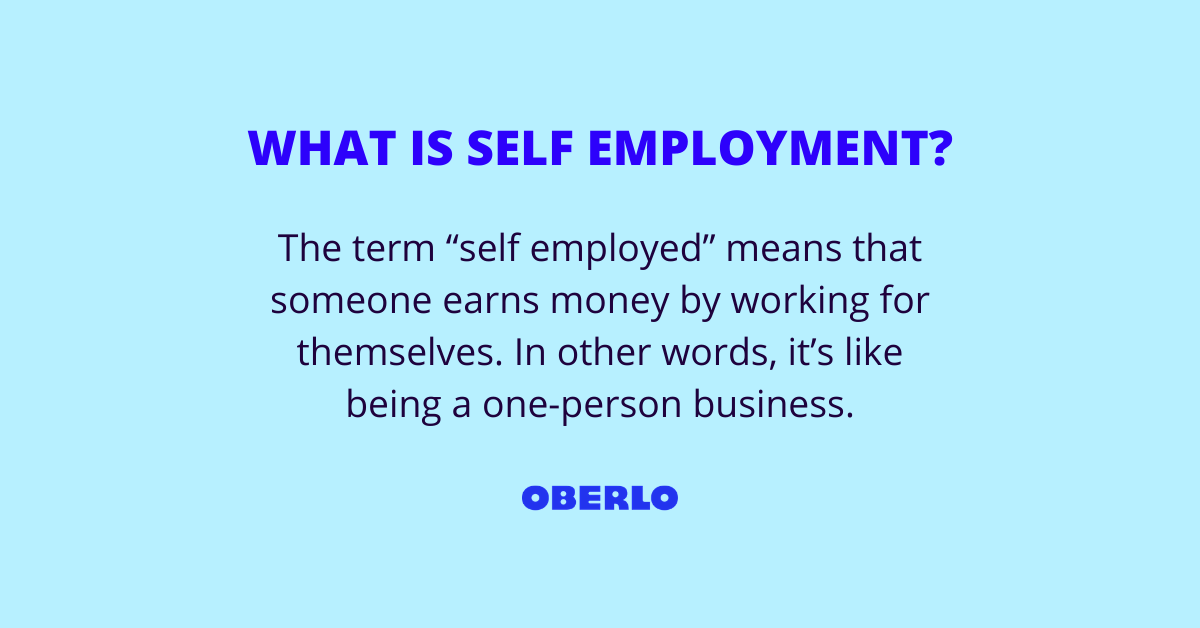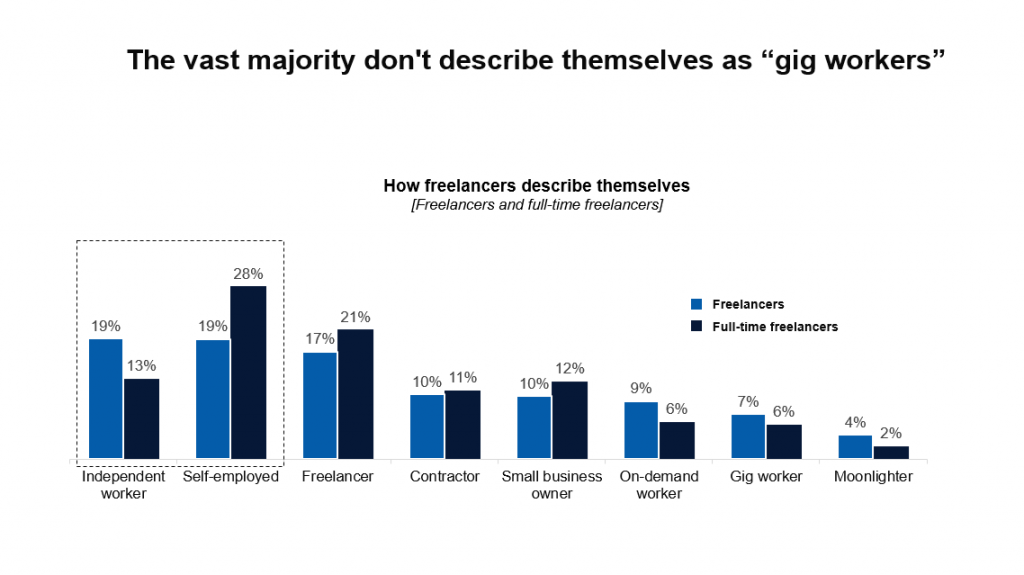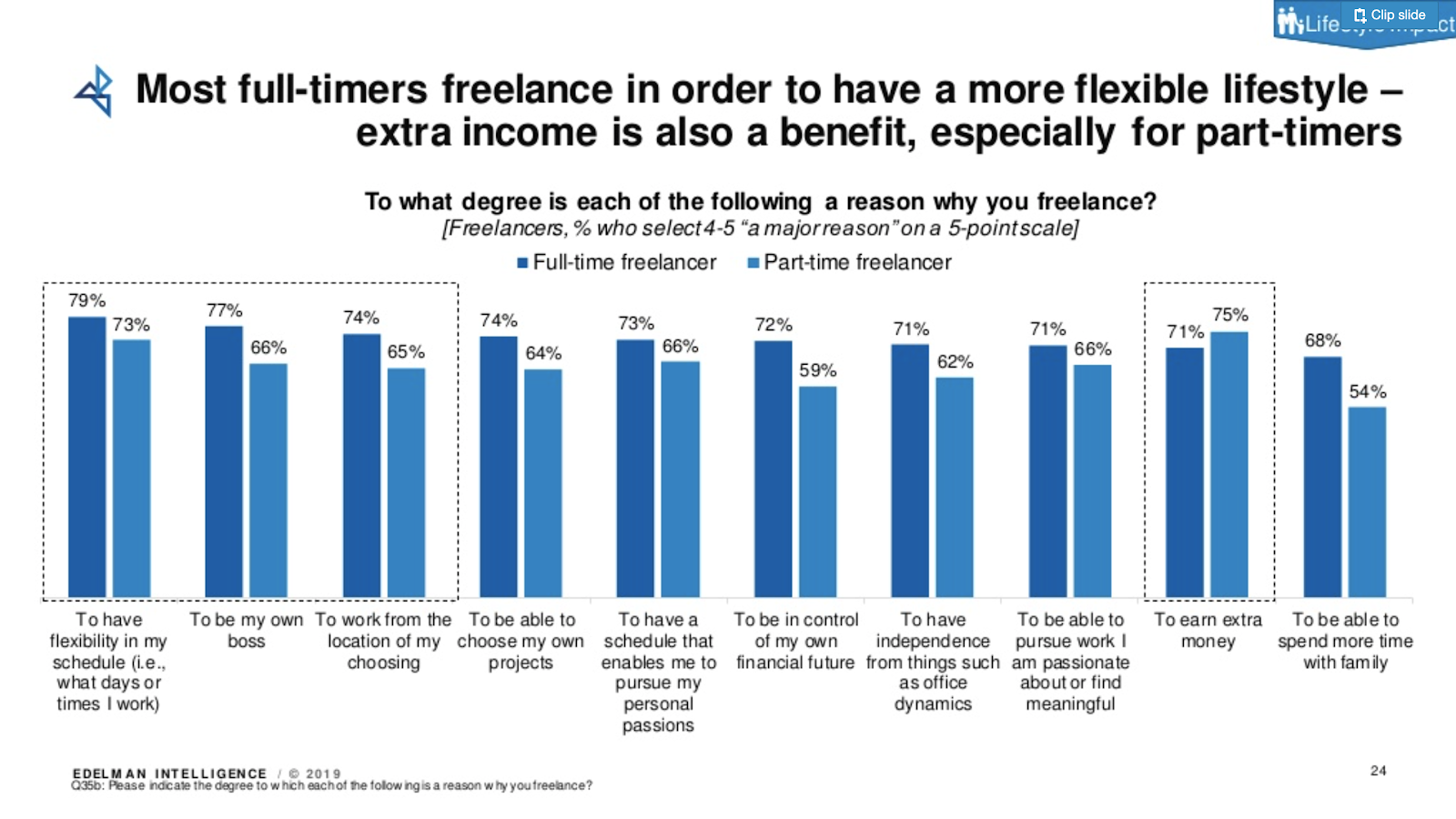Exploring how to become self-employed? Smart thinking!
Becoming self-employed allows you to be your own boss, set your own hours, work from home, and spend more time with your family.
No wonder the number of self-employed people is on the rise.
According to Zippia, in 2022, more than 70 million Americans are engaged in freelancing—one of the most popular types of self-employment.
But what is self-employment? What exactly are the advantages of self-employment?
In this article, you’ll learn all about self-employment and its types. And stick around until the end for a list of 50 top self employment ideas.
What is self-employment?
The term “self-employed” means that someone earns money by working for themselves instead of for another person or company. In other words, it’s like being a one-person business.

→ Click Here to Launch Your Online Business with Shopify
Here are five examples of self-employment:
- Freelance writer
- Certified financial planner
- Local handyperson
- Food truck owner
- Farmers
According to the Internal Revenue Service (IRS), you’re considered self-employed if you:
- Carry on a trade or business as a sole proprietor or an independent contractor.
- Are a member of a partnership that carries on a trade or business.
- Otherwise have your own business (including a part-time business).
Now, let’s take a closer look at some common types of self-employment.
Types of self-employment
People who work for themselves go by many different names. Most prefer the general terms “independent worker” or “self-employed.”
However, self-employed individuals go by names that provide more insight into the type of self-employment they’re involved in.

Let’s take a closer look at some different types of self-employment.
Freelancers
A freelancer is someone who provides services to clients with no expectation of ongoing work. Many freelancers work with multiple clients at a time. Common examples include freelance writers, designers, and photographers. With millions of freelancers finding work online, checking out remote job sites where you can find this type of work easily should be your first port of call.
Small-business owners
The term “small-business owner” is broad and can apply to the owner of any small business that sells products or services. Generally speaking, most small-business owners work to develop a sustainable business with systems and processes.
Common examples of small businesses include mom and pop stores, independent cafés, and ecommerce businesses.
Independent contractors
Independent contractors provide services under the terms of a written or verbal contract. These contracts can be project-based or time-based.
Some independent contractors work full-time for one company and resemble an employee. However, as an independent contractor, they’re responsible for paying their own self-employment taxes (Social Security, Medicare, etc.).
Common examples include realtors, web developers, and project managers.
Side hustlers
This type of self-employment refers to people who earn money working for themselves while also being employed by others full time or part time.
For example, a journalist employed by a newspaper might also write freelance articles for other publications. Or a full-time employee could work 10 hours a week doing something they love, like getting a photography business up and running.
Benefits of self-employment
Why be self-employed?
According to a study by Upwork and the Freelancers Union, most full-time freelancers prefer to be self-employed because it allows them to have a more flexible lifestyle.
Additionally, the self-employed want to:
- Be their own boss
- Work from the location of their choosing
- Choose the projects they work on
- Have a schedule that enables them to pursue their personal goals
- Be in control of their financial future
- Have independence from factors such as office dynamics
- Be free to pursue work they’re passionate about or find meaningful
- Have the ability to pivot their skills and projects when it suits
- Spend more time with family

A self-employed job also opens up opportunities for individuals who would prefer not to work for a traditional employer due to personal circumstances, such as a disability, the need to take care of a loved one, or being a single parent.
But isn’t self-employment insecure and unpredictable?
“You can think of freelancing as volatile and risky, or as flexible and opportunity-rich,” says Sara Horowitz, author of The Freelancer’s Bible. “Doesn’t having multiple sources of income and multiple money-making skills sound less risky than putting all your eggs in one employer’s basket? Freelancing lets you shift gears when the world does.”
The downside of self-employment
It would be unfair to say that there are only advantages to self-employment. There are some disadvantages to it also.
For instance, you need to find clients and work on your sales abilities so you can generate profit and pay the rent.
You also need to be a jack-of-all-trades. Self-employment forces you out of your comfort zone, and into learning new things every day, such as marketing, sales, project management, client management, customer service, payroll, invoicing, and so much more.
Finally, you might work alone most of the time, so you may not have a good support system in place, like if you were working with a team of people. This can lead to mental health issues that you need to nip in the bud as soon as possible.
Signing up for mindfulness classes, attending events for people in similar situations, and maintaining a good physical and social calendar can help ensure your mental health doesn’t suffer when you become self-employed.
How to become self-employed in 5 steps
1. Choose your target audience
The first step to becoming self-employed is identifying the people you want to serve. It pays to be specific here, because not everyone will be interested in your product or service. Ideally, you want to target a very specific solution to a very specific set audience.
For example, if you sell women’s fragrances, you can create a unique campaign targeting females working 9-to-5. Something like “smell great all day” should divert their attention to your products.
2. Complete the administrative steps
Next, decide on a business structure. This involves seeing whether it makes sense to go for a sole proprietorship or register an LLC (limited liability company). Plus, check whether you need any specific permits or licenses to sell the product or service you have in mind.
Since there are so many administrative steps involved in becoming self-employed, I recommend working with an agency specializing in business registration. It will save you time and even cost by helping you avoid errors. If you need funding, get in touch with the Small Business Administration to help connect you with potential lenders.
3. Invest in the right systems
Systems are the lifeblood of a business, so make sure to choose the right ones for your venture. For example, if you sell ecommerce products, you can use an online payments solution like Shop Pay to improve the checkout experience. Want to keep track of your customers? A CRM can help you view and segment their profiles without hassle.
Think of all the systems you’ll need to run your business efficiently and take trials to evaluate whether they’d be valuable to your setup.
4. Decide where you’ll work
Self-employment provides a lot of flexibility when it comes to where and how you’ll work. You can choose to sit at a co-working facility, rent your own office space, or work from the comfort of your home.
Think about where you’ll be the most productive and start there. If working from home comes with other duties—like feeding kids and doing laundry—a co-working space may be the better option for you.
5. Market your product or service
Finally, introduce your offering to the world. Whether you sell a product or service, use tactics like social media marketing, email marketing, and SEO to get the word out. You can even use offline marketing tactics such as direct mail and experiential marketing to reach audiences if it makes sense for your business.
Hot tip: Participate in community events and make connections to improve your visibility. Connect with potential customers, other self-employed people, and business owners—basically everyone who can support you along your journey.
50 best self-employment ideas
Interested in self-employment opportunities? Here’s a list of 50 self-employment ideas to inspire your journey!
Self-employment ideas to harness your internet savvy
- Join an affiliate program
- Become a social media influencer
- Model for brands and creators
- Start a blog
- Be a YouTuber and make money
- Manage social media campaigns and accounts
Sell goods online with these self-employment opportunities
- Sell products online with Shopify
- Dropship products online with DSers
- Sell print-on-demand products
- Sell your homemade creations on Etsy
Self-employment opportunities that take advantage of your work or career experience
- Teach English online
- Tutor math, sciences, or the arts
- Edit and proofread for students
- Write marketing and sales copy
- Create web content for businesses
- Write an ebook
- Create and sell an online course
Offer your professional services with these self-employment ideas
- Sell your graphic design services
- Offer web development services
- Become a portrait, event, or wedding photographer
- Sell your stock photos on Burst, Shutterstock, Pexels, and iStock
- Edit photos, audio, or video
- Become an interior designer
- Keep books or do accounting
- Consult on social media marketing or advertising strategies
- Create a business plan for local businesses
- Repair home electronics
Self-employment ideas that utilize your people skills
- Coach others on their careers
- Be a motivational speaker
- Coach people on public speaking
Put your organization skills to work with these self-employment opportunities
- Plan events and weddings
- Be a personal or virtual assistant
Self-employment ideas that allow you to employ your life experience
- Start your own day care center
- Walk or sit pets
- Tailor clothes and other household items like curtains, drapery, and linen
- Clean houses and commercial spaces
- Offer decluttering and organizational services
- Pack and unpack for movers
- Be a gardener
- Be a personal cook or food caterer
Put your training to work with these self employment opportunities
- Teach yoga, pilates, or dance
- Be a personal fitness trainer
- Work as a freelance barber or a hairdresser
- Do professional makeup for special occasions, events, or film sets
- Be a personal shopper
- Become a massage therapist
Self-employed jobs that allow you to work with your talents
- Do voice-overs
- Create a podcast
- Sing or dance at events and venues
- DJ at parties or events
Self-employment has a lot to offer
Self-employment is the process of earning money from your own endeavors, instead of being employed by someone else.
Self-employed individuals go by different names, such as freelancers, independent contractors, and small-business owners.
There are tons of advantages to self-employment, too. Many people enjoy being self-employed because they can be their own boss, have a flexible schedule, and work from home.
All in all, self-employment isn’t for everyone. If you’re one of these people, you might agree with businessman and speaker Farrah Gray, who said, “Build your own dreams, or someone else will hire you to build theirs.”






